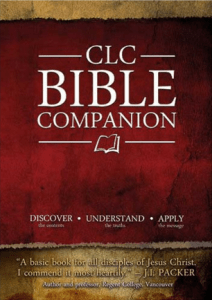Dealing with Sin
From the CLC Bible Companion
By his death, Jesus dealt with the sin that has so devastatingly disrupted the life of God’s world and its fellowship with him.
UNDERSTANDING SIN
The early Christians expressed their understanding of the significance of Jesus’ death with a simple summary statement: “Christ died for our sins, according to the Scriptures” (1 Corinthians 15:3). This short summary, however, called to mind a whole world of meaning from the Old Testament, which helped the first Christians to understand what Jesus had done for them. For a start, Jesus had done something about “sin”.
- A history of sin.
In the Old Testament, sin was not a vague term referring to general moral failings, as it is sometimes used today. Sin could only be named as “sin” within a particular context: the context of relationship with God. God had established the world as a place where humans could flourish in life as they remained in constant, obedient fellowship with him (Genesis 2:15-17). But, no sooner had this relationship been established, than humans stepped outside its boundaries by disobeying God’s command (3:6), and so losing the blessings of life with him (3:16-24). From then on, sin was always “lurking at the door” (4:7), disrupting the peace of God’s creation, and turning humans away from him.
Throughout the Old Testament, God called a particular people to come back into fellowship with him. He rescued the nation of Israel from slavery in the land of Egypt so that there would once again be people who would enjoy life as he had intended. He made a covenant with them, committing himself to them and asking them to commit to him. To help them live constantly within this covenant, he gave them the gift of a law, known as the Torah, which described the kind of life that remained within the boundaries of his covenant. Obeying God’s Torah was not supposed to be a heavy burden, but a joyful delight – it affirmed that God wanted his creation to be blessed. As Israel stayed close to him, they would show the rest of the world what God’s life-giving holiness looked like (Exodus 19:5-6). However, sin was still “lurking at the door”, and the people of Israel were quick to go out to it, and let it into their midst. Time after time, sin disrupted God’s covenant, and turned his people away from him.
- A definition of sin.
Simply put, sin is missing the way of life that God intends. Within the context of Israel, this way of life had been clearly described by God’s good commands in the Torah (see Psalm 119, a song of praise to God for his law). Sin in Israel, therefore, was to disobey God’s law and step outside his holy way of life. It could happen deliberately, as God’s people intentionally turned away from him, or unintentionally, as they were simply caught up in the waywardness of the world around them (see Leviticus 4). Importantly, sin is not simply an action – failing to live up to a list of do’s and don’ts – but an attitude of the heart: human life that is out of step with God from the very centre of its being.
- The result of sin.
The Old Testament had many different ways to describe the consequences of sin, all of them negative. It caused banishment from God’s blessing (Genesis 3:24); it created uncleanness that spread like a malicious virus through society (see Leviticus 5:2); it brought guilt and shame and despair (Psalm 6:1-7); it grew unchecked into whole systems of evil and injustice (eg Amos 1–2); and it resulted in the ultimate banishment from God’s presence – death. God’s constant judgement about sin was that it had to be removed if people were to live. If it were not removed, then they would die, both now and eternally.
UNDERSTANDING SACRIFICE
The first Christians proclaimed that Jesus had “died for sin”. The background to this was the sacrificial system of the Old Testament. Through sacrifice, God had provided a way for sin to be dealt with, so that his people would not be swept away by his judgement about sin and its disastrous consequences, but rather be restored to life and fellowship with him.
- The sin offering.
Leviticus 4:1–5:13 describes the procedure for presenting a sacrifice for sin to God. To us today, the amount of bloodshed involved in these sacrifices may seem excessive, but in the ancient context where animals were sacrificed by all societies in their thousands and millions, God’s instructions were in fact restrained and gracious – there was a standard procedure and by following it closely the worshipper could know that they were back in fellowship with God. They did not need to sacrifice for the same sin twice. The procedure was clear: if a person sinned, they were to bring an animal to the priest, confess the sin and lay their hand on the head of the animal as it was slaughtered. This signified that this costly sacrifice had died in the place of the sinner. Blood was sprinkled inside the sanctuary, signifying that God had accepted the offering and the carcass of the animal was completely burned up. The sin had been removed from the sinner, so that it could no longer riddle the fellowship of God’s people with its devastating consequences. The priest would declare the sin “forgiven”, which meant that God and his people were once again “at one” (atonement, Leviticus 4:20,26,31, etc.). The death of the sacrifice meant the life of the worshipper.
- The Day of Atonement.
Once a year, all Israel observed the Day of Atonement, on which the whole nation was cleansed (Leviticus 16:34). Central to the proceedings were two goats. On this day alone, the high priest entered the Most Holy Place, with a bowl of blood from one of the goats. He came out of the Most Holy Place and made atonement for each area of the sanctuary in turn, in order to show clearly that forgiveness and cleansing had been initiated by God himself (16:15-19). Then the high priest laid hands on the second goat and confessed over it all the sins of Israel. It would be sent out into the wilderness, where it would die, signifying that God had removed sin from the people completely – the goat had borne it away (16:22). Free of sin, God’s people were re-established in their relationship with him, and could go in peace to live out his covenant in their lives. Once again, a sacrifice had died in order to let God’s people live.
JESUS, THE SACRIFICE FOR SIN
The first Christians understood Jesus’ death as a sacrifice for sin against this Old Testament and contemporary Jewish background.
- The sacrifice of the new covenant.
Jesus’ death brought God’s covenant with Israel to its climactic end (Romans 10:4) and ushered in a new, better covenant. The old covenant, which included the sacrificial system, had been intended to cleanse Israel from their sin so that they could demonstrate to the nations what it meant to live in intimate fellowship with God. But throughout their history, God’s people had struggled to stay in fellowship with him, time and again being overwhelmed by sin and its consequences. The constant sacrifice of animals was not working – sin was still rampant among God’s people.
The writer of Hebrews had grasped the profound significance of Jesus’ death. Unlike the sacrifices in the temple, which had to be offered time after time because they never really cleansed the worshipper (10:4), Jesus “has appeared once for all at the end of the age to remove sin by the sacrifice of himself ” (9:26). Jesus was the reality of atonement, of which all the Old Testament sacrifices had just been shadows and anticipations (“sketches of heavenly things”, 9:23). His sacrificial death had brought about a new covenant relationship with God.
- The universal sacrifice.
As part of the new covenant, Jesus’ sacrifice was not just for Israel, but for the whole world. John the Baptist had said, recalling the imagery of the Day of Atonement, that Jesus was “the Lamb of God who takes away the sin of the world” (John 1:29). Certainly, he had been crucified as a direct result of the sin of those who rejected him; but in a profound sense, he had died with the weight of the whole world’s sin on his shoulders. The world is the sort of place where the Son of God, who brings only grace and truth, can be crucified (John 1:10-11,17). But because of Jesus’ sacrifice, it is also the sort of place that can be freed to live with God.
- A liberating and cleansing sacrifice.
As Jesus explained to his disciples at the Last Supper, he was going to his death to bring about the forgiveness of sins (Matthew 26:28). He would bear the devastating agony of sin’s true consequences in his own body, so that others would not have to. At the moment he died, the curtain into the Most Holy Place in the temple was torn in two (Matthew 27:50-51). The way in to fellowship and new life with God – the way that had been blocked by sin – had now been opened for all (see Ephesians 2:18; Hebrews 10:19-20; 1 Peter 3:18). But also, as pictured by the Day of Atonement, God’s cleansing power could sweep out of the temple into the world. Through Jesus, all can be cleansed and purified, so that they may worship God with the life he always intended (Hebrews 9:14).
Jesus’ sacrificial death is, in fact, central to his announcement of the kingdom. Without being set free from sin, it would be impossible for his followers to share in the life of God’s promised kingdom. Without a sacrifice for sin, God’s judgement about sin would remain over them – their lives would end in death (Romans 6:23). However, because he died “for our sins” (1 Corinthians 15:3), bearing them away in his own body (1 Peter 2:24), people who come to him are set free from sin to live in God’s new covenant, looking forward to the fulfilment of their salvation in his new creation. Jesus’ death as a sacrifice for sin enables a great, gracious exchange to take place: he took our sin, so that we might share in his righteousness (2 Corinthians 5:21; Romans 3:21-26)!
 About The CLC Bible Companion The CLC Bible Companion is an all-in-one guide to the Bible that is both a comprehensive reference book and an exciting companion. Its goals for you are to: Know Jesus Christ, Discover the Contents of the Bible, Explore the Truth of the Bible, and Believe and Experience the Message of the Bible. The CLC Bible Companion is on special promotion for a limited time, you may purchase the CLC Bible Companion for $10.00 while supplies last. (retail price $29.99 for hardcover) To learn more about the CLC Bible Companion and purchase, please visit: https://www.clcpublications.com/deals-discounts/
About The CLC Bible Companion The CLC Bible Companion is an all-in-one guide to the Bible that is both a comprehensive reference book and an exciting companion. Its goals for you are to: Know Jesus Christ, Discover the Contents of the Bible, Explore the Truth of the Bible, and Believe and Experience the Message of the Bible. The CLC Bible Companion is on special promotion for a limited time, you may purchase the CLC Bible Companion for $10.00 while supplies last. (retail price $29.99 for hardcover) To learn more about the CLC Bible Companion and purchase, please visit: https://www.clcpublications.com/deals-discounts/
Download Free PowerPoint Resources for your Bible Studies:









Leave a Reply
Want to join the discussion?Feel free to contribute!